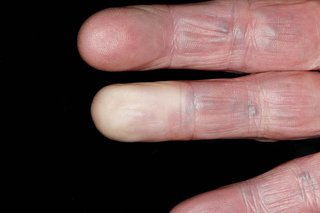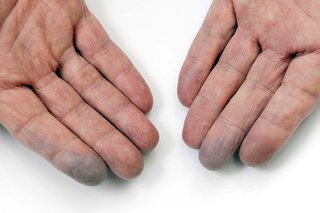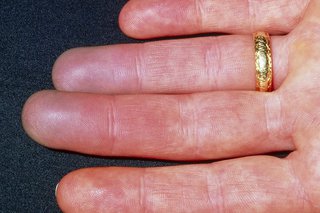Raynaud's phenomenon is common and does not usually cause any severe problems. It affects your hands and feet where your fingers and toes turn white. They gradually become blue or purple and then become bright red and often painful.
Usually it is brought about by a sudden change in temperature such as putting hands under a cold water tap or even taking something from a fridge or freezer.
Initially the fingers or finger can go white and you can also have numbness followed by your fingers becoming blue. The return of circulation can become painful with pins and needles.
Raynaud's can also be brought on by stress.
Who is affected by Raynaud's
Raynaud's phenomenon generally affects young people. The condition affects women more than men.
When the onset of symptoms affects those over 40 it may be associated with other conditions such as rheumatoid arthritis or similar types of conditions.
This can be more severe and serious and can lead to sore and even skin loss from the fingers. The most severe form being associated with scleroderma.
Check if it's Raynaud's
Raynaud's affects your blood circulation. When you're cold, anxious or stressed, your fingers and toes may change colour.
Other symptoms can include:
- pain
- numbness
- pins and needles
- difficulty moving the affected area



Some people also find their ears, nose, lips or nipples are affected.
The symptoms of Raynaud's may last from a few minutes to a few hours.
If you're not sure it's Raynaud's
| Symptoms | Possible causes |
|---|---|
| Symptoms Pins and needles that lasts for a few minutes | Possible causes Resting or sleeping on part of the body |
| Symptoms Breathing too quickly, trembling hands, pins and needles, but fingers do not change colour | Possible causes Hyperventilation |
| Symptoms Burning or itchy swelling on fingers and toes, happens after being very cold, gets worse as you warm up | Possible causes Chilblains |
Things you can do to help with Raynaud's
Do
-
keep your home warm
-
wear warm clothes during cold weather – especially on your hands and feet
-
exercise regularly – this helps improve circulation
-
try breathing exercises or yoga to help you relax
-
eat a healthy, balanced diet
Don't
-
do not smoke – improve your circulation by stopping smoking
-
do not drink too much tea, coffee or cola. Caffeine and other stimulants can stop you relaxing
Non-urgent advice: See a GP if:
- your symptoms are very bad or getting worse
- Raynaud's is affecting your daily life
- you only have numbness on one side of your body
- you also have joint pain, skin rashes or muscle weakness
- you're over 30 and get symptoms of Raynaud's for the first time
- your child is under 12 and has symptoms of Raynaud's
- you develop wounds or sores
Treatment for Raynaud's from a GP
A GP may prescribe a medicine called nifedipine if your symptoms are bad or getting worse. This helps your circulation.
Some people need to take nifedipine every day. Others only use it to prevent Raynaud's, for example, during cold weather.
You may need to get a blood test. In rare cases, Raynaud's could be a sign of a more serious condition, such as rheumatoid arthritis or lupus.
If the condition is serious and disrupting your life, certain medications are given to prevent the constriction of the little arteries in the fingers or toes. These medications are often used to treat raised blood pressure.
Content supplied by the NHS and adapted for Ireland by the HSE
